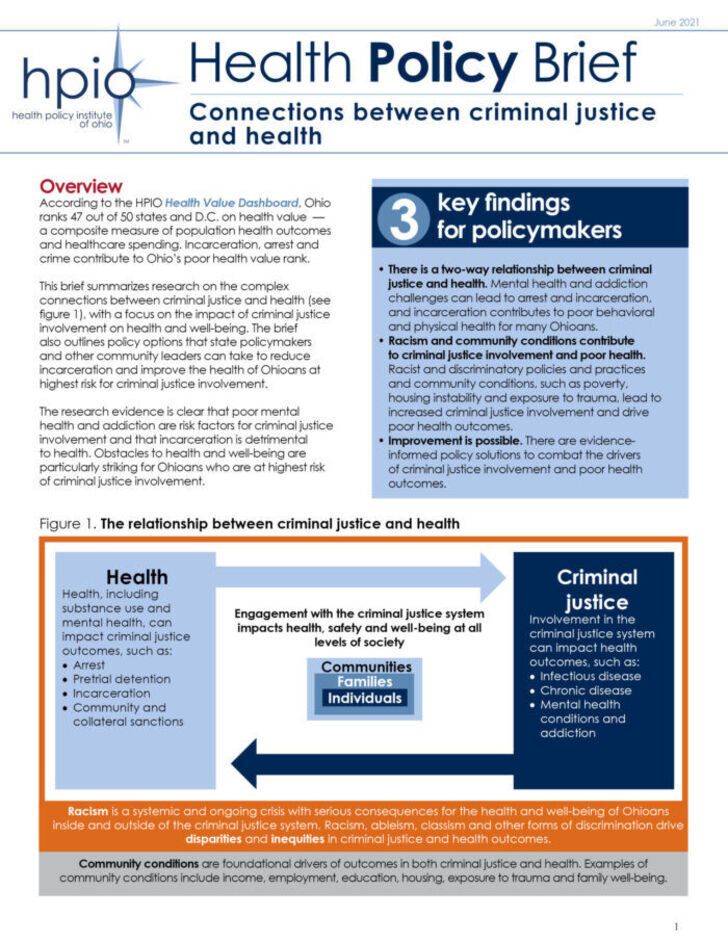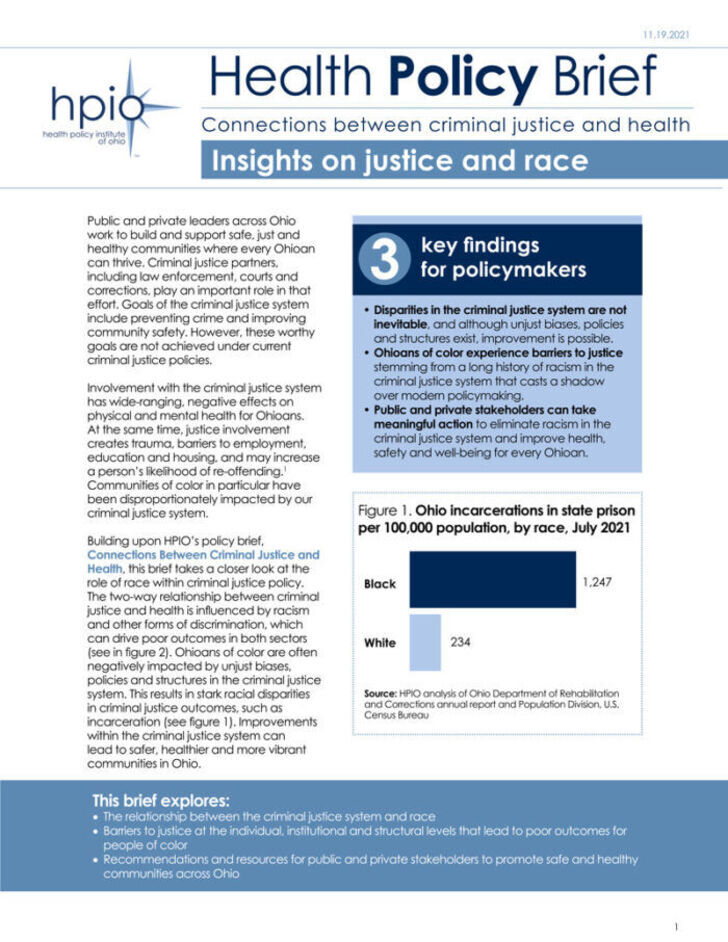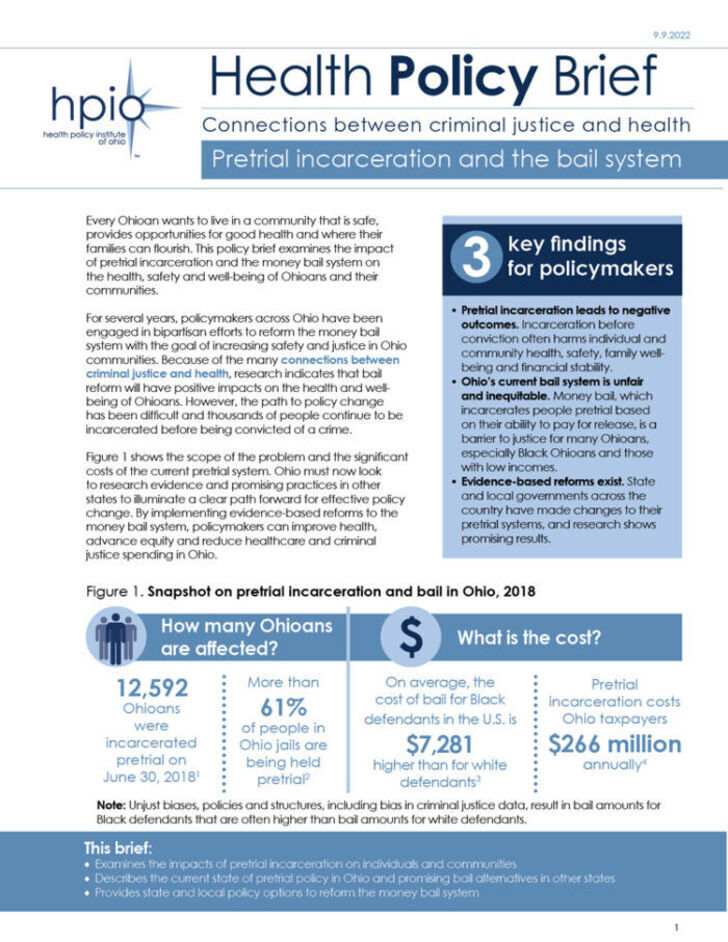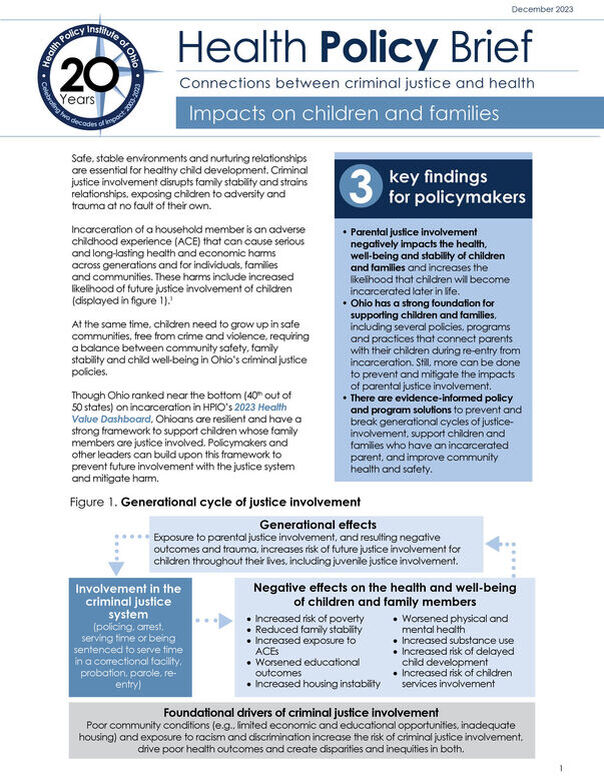Criminal Justice and Health
Note: Some publications were published prior to the current year. For most-recent data, consult the data sources at the end of the publication.
Graphics
Use HPIO graphics and data in your work. To use the data graphics in your presentations, click here to access the slides on Google Drive, click “File” and then “Download.” This will allow the option to download individual slides or the full deck into PowerPoint slides, a jpg, pdf or other available media files.
Data points
Connections between criminal justice and health
Key data findings
- In 2019, Ohio had one of the highest adult imprisonment rates among all 50 states, ranking 39th with 430 adults per 100,000 population serving sentences in state or federal prisons.
- Nationally and in Ohio, Black Americans are incarcerated in state prisons at more than five times the rate of white Americans.
- Incarceration is costly for Ohio. It costs about $30,558 per year to incarcerate one person in a state prison, and Ohio taxpayers will spend nearly $1.5 billion dollars on state prison incarceration this year.
- Lack of access to behavioral health treatment results in exacerbated addiction and mental health conditions and can lead to criminal justice involvement. In 2016-2017, 20% of Ohioans ages 18 and older did not receive needed mental health treatment or counseling.
- Collateral sanctions are legal restrictions on the rights, benefits and opportunities of people who have been charged or convicted of crimes. When compared to other states and D.C., Ohio ranks 49 out of 51 for states with the most collateral sanctions.
Suggested citation: “Connections between criminal justice and health,” Health Policy Institute of Ohio, June 2021.
Connections between criminal justice and health: Insights on justice and race
Key data findings
- The drug arrest crime rate for Black Ohioans was 2.4 times higher than that for white Ohioans in 2020.
- Black Ohioans making up 45% of the state prison population while only 17% of treatment court participants are Black.
- On average, the cost of bail for Black defendants is $7,281 higher than for white defendants.
Suggested citation: “Connections between criminal justice and health: Insights on justice and race,” Health Policy Institute of Ohio, 2021.
Connections between criminal justice and health: Pretrial incarceration and the bail system
Key data findings
- More than 61% of people in Ohio jails are being held pretrial (12,592 Ohioans were incarcerated pretrial on June 30, 2018)
- On average, the cost of bail for Black defendants in the U.S. is $7,281 higher than for white defendants
- Pretrial incarceration costs Ohio taxpayers $266 million annually
Suggested citation: “Connections between criminal justice and health: Pretrial Incarceration and the bail system,” Health Policy Institute of Ohio, 2021.
Connections between criminal justice and health: Impacts on children and families
Key data findings
- In 2022, 5,397 Ohio children were removed from the home due to parent/family issues, including parental incarceration.
- In 2021, 13.2% of Ohio adults reported having a parent or guardian serve time in jail after they were born. However, due to systemic inequities (i.e., racism and discrimination and poor community conditions), Black and Hispanic/ Latino Ohioans were almost twice as likely as white Ohioans to report their child having a parent or guardian serve time in jail after they were born.
- In 2021, Black Ohioans were 5.6 times more likely to be incarcerated than white Ohioans because of biases that have been built into the policies and structure of the criminal justice system over time.
- HPIO analysis found that if household member incarceration (an adverse childhood experience) was prevented,12% fewer Ohioans would have limited healthcare access due to cost.
- HPIO analysis found that if Ohio children were not exposed to familial incarceration (an adverse childhood experience), Ohio’s overall smoking rate would decrease by 7%.
Suggested citation: “Connections between criminal justice and health: Impacts on children and families,” Health Policy Institute of Ohio, Dec. 2023.
Funding for this project was provided by the Ohio State Bar Foundation and HPIO’s core funders. Click here to view all of HPIO’s criminal justice and health work




